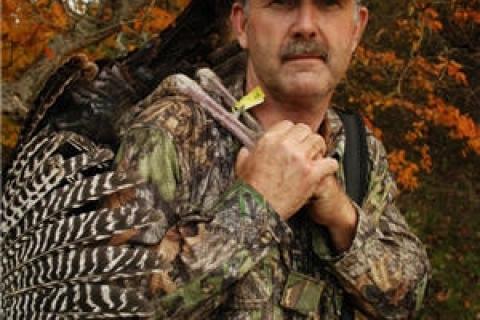
 |
| Spend time scouting in the area you intend to hunt turkey and look for sign. |
With the resurgence in wild turkey populations across the country in the last 30 years, many states have opened fall turkey hunting seasons in addition to spring seasons. Although fall turkey hunting has not grown in popularity like the spring season, it is, according to turkey hunting guru Ray Eye, "the best time of the year to be in the turkey woods."
However, a lack of information about fall hunting strategies is what holds a lot of hunters back. The following tips from Ray Eye can change all that and help you get on the right foot with your fall turkey hunting adventures.
- Find birds by calling - Trouble locating fall turkeys is one of the main reasons so few hunters take advantage of the fall seasons. "Most hunters go afield with the wrong ideas about how to find fall birds," said Eye. "Many hunters do not like the fall season, because they say that gobblers do not gobble and give away their location like they do in the spring. Gobblers do gobble in the fall, but for different reasons than in the spring, when they are looking for mates. Hunters should use a turkey call to produce hoarse gobbler yelps and clucks to locate gobbler flocks. They will gobble and fight, too. To locate hens and young of the year, learn how to kee-kee."
- Look for sign - "If you find droppings, discarded feathers, scratchings and tracks, guess what. There are turkeys in the area," says Eye. "If you do not find this kind of sign in the area you want to hunt, go elsewhere and repeat your search. Look along ridges where oaks grow. Turkey flocks scratch up large areas looking for acorns. Check old road beds for bowl-sized dusting areas. Check old fields for droppings. Young birds chase grasshoppers in such openings."
- Shoot your gun - "I hear sad turkey hunting stories all the time at my seminars," Eye said. "It is amazing how many hunters go out turkey hunting without shooting their gun since last year. There is nothing more disappointing than pulling the trigger and watching a turkey fly off only to remember that you still had a skeet choke in your gun from a previous round of clays. Pattern your shotgun. Check your choke. Check your shot shells. It is very easy to do and you will be much happier with your results."
- Carry several calls - "Weather conditions and terrain features can greatly reduce the effectiveness of calling," Eye explained. "Carrying a variety of calls will keep a hunter prepared for all conditions. Box calls and slate calls can produce volume on windy days. Too, they produce different tones than mouth and tube calls. Mouth calls are great for producing realistic gobbler yelps and soft calls of young birds."
- Exercise patience - "If you are hunting fall gobblers, you are trying to match wits with the wildest creature in the woods, Eye stated. "Turkeys have small brains, but their instincts are keen. An old gobbler may take an hour or more to come into your calls. Stick with it. The same holds true of young birds. Generally, they come back quickly after being scattered, but sometimes take their easy time. They are there. just wait them out.
Employing these hunting tactics will greatly increase your odds of harvesting a fall turkey. And Thanksgiving takes a whole new meaning when you serve wild turkey for dinner.
Bass Pro Shops has a complete selection of hunting gear for your next turkey hunt.
- 5759 views

